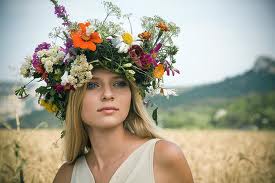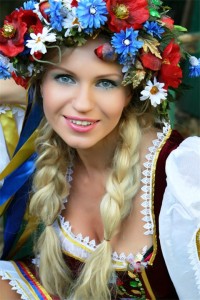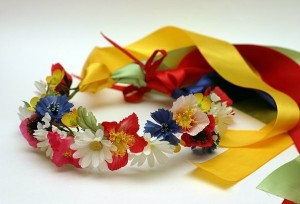 The Ukrainian customs and traditions are undoubtedly very spectacular and impressive. One of such traditions is wearing the wreath, the vinok in Ukrainian. It is the essential component of modern folk or even wedding dressing, the last modern trend. But it rooted in ancient, pre-Christian times, when its wearing had the significant own meaning and served as the status marker of the girl.
The Ukrainian customs and traditions are undoubtedly very spectacular and impressive. One of such traditions is wearing the wreath, the vinok in Ukrainian. It is the essential component of modern folk or even wedding dressing, the last modern trend. But it rooted in ancient, pre-Christian times, when its wearing had the significant own meaning and served as the status marker of the girl.
 The wreath has a lot of variations, common and local ones. It was made of artificial or natural flowers; each of them had its own meaning and sense, according to the regional legends and beliefs. The ancient Greeks still believed that the wreath served as a kind of messenger, carrying the entreaties and messages ahead to the Gods. The ancient Slavs considered a wreath to protect maidens from evil spirits. Especially important role the wreath had during Kupala Night, i.e. Feast of St. John the Baptist. This celebration is known to be a pagan rite of fertility, and the wreath thus symbolized the cult of Sun and was supposed to be lucky amulet. Girls during this celebration weaved their wreaths with lighted candles to cast on the river. In this way, they forecasted their future life. If the wreath stopped deadly its floating and didn’t float down the water, the girl would probably not marry (future year at least). If the wreath went under the water, it would be a bad omen for a girl, who might die. If the wreath went out the river, miseries, misfortunes and illnesses would follow it and the next year promised to be lucky.
The wreath has a lot of variations, common and local ones. It was made of artificial or natural flowers; each of them had its own meaning and sense, according to the regional legends and beliefs. The ancient Greeks still believed that the wreath served as a kind of messenger, carrying the entreaties and messages ahead to the Gods. The ancient Slavs considered a wreath to protect maidens from evil spirits. Especially important role the wreath had during Kupala Night, i.e. Feast of St. John the Baptist. This celebration is known to be a pagan rite of fertility, and the wreath thus symbolized the cult of Sun and was supposed to be lucky amulet. Girls during this celebration weaved their wreaths with lighted candles to cast on the river. In this way, they forecasted their future life. If the wreath stopped deadly its floating and didn’t float down the water, the girl would probably not marry (future year at least). If the wreath went under the water, it would be a bad omen for a girl, who might die. If the wreath went out the river, miseries, misfortunes and illnesses would follow it and the next year promised to be lucky.
 Traditionally, the wreath was worn by girls and young unmarried women. It consists of flowers, flowering herbs and plants. By the rules in traditional wreath twelve flowers and herbs should be woven. Each plant symbolizes something and has a clearly certain meaning. Usually the wreath consists of viburnum, immortelle, forget-me-not, periwinkle, marigolds, daisy, mallow, yarrow, lovage, poppy, hops and cornflower. The poppies were considered to be the symbol of sorrow for the dead; the poppies wreath was usually worn by widows. Viburnum meant health and maiden beauty, periwinkle – immortality, daisy – youth, kindness and gentleness, lovage and cornflower – loyalty, immortelle – health, mallow – hope and faith, forget-me-not promised memory, yarrow represented unconquerable insubordination, hops meant mind. The color of ribbons was also important. The first interwined ribbon should be brown, meant the earth. Yellow ribbon meant sun, blue and navy (symbols of air and water) meant health. Orange meant bread, purple – wisdom, crimson – sincerity. Pink ribbons represented girls from a wealthy family, green ribbon symbolized youth.
Traditionally, the wreath was worn by girls and young unmarried women. It consists of flowers, flowering herbs and plants. By the rules in traditional wreath twelve flowers and herbs should be woven. Each plant symbolizes something and has a clearly certain meaning. Usually the wreath consists of viburnum, immortelle, forget-me-not, periwinkle, marigolds, daisy, mallow, yarrow, lovage, poppy, hops and cornflower. The poppies were considered to be the symbol of sorrow for the dead; the poppies wreath was usually worn by widows. Viburnum meant health and maiden beauty, periwinkle – immortality, daisy – youth, kindness and gentleness, lovage and cornflower – loyalty, immortelle – health, mallow – hope and faith, forget-me-not promised memory, yarrow represented unconquerable insubordination, hops meant mind. The color of ribbons was also important. The first interwined ribbon should be brown, meant the earth. Yellow ribbon meant sun, blue and navy (symbols of air and water) meant health. Orange meant bread, purple – wisdom, crimson – sincerity. Pink ribbons represented girls from a wealthy family, green ribbon symbolized youth.
